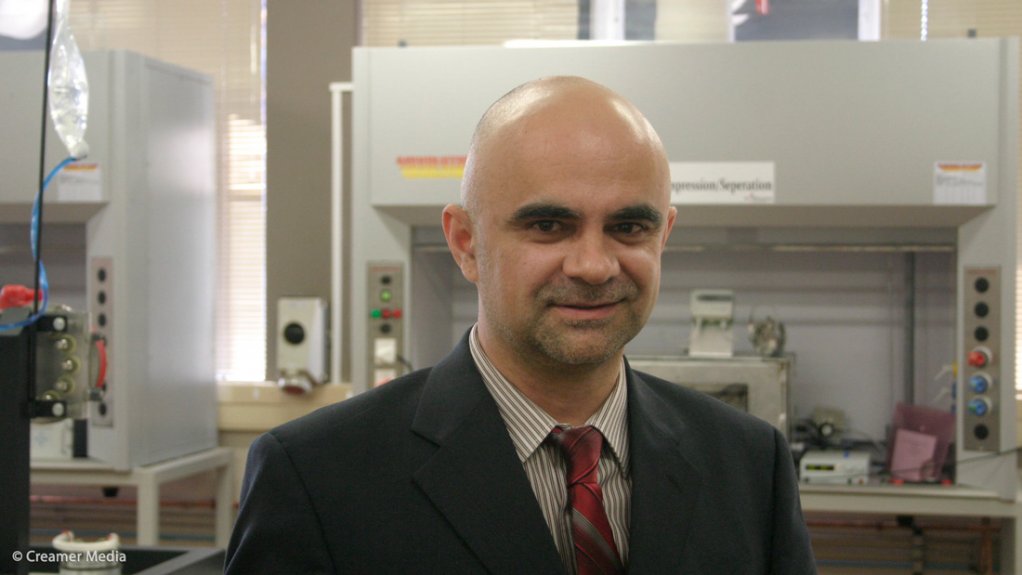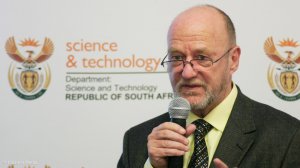SA advances hydrogen strategy with launch of new research centre




Science and Technology Minister Derek Hanekom
Photo by Megan Wait
HySA Infrastructure CoC director Dr Dmitri Bessarabov
Photo by Megan Wait
South Africa is further advancing its strategy of developing commercial activities in hydrogen and fuel cell technologies with the launch of the Hydrogen South African (HySA) Infrastructure Centre of Competence (CoC) in the North West province.
The HySA Infrastructure CoC is co-hosted by the North-West University and the Council for Scientific and Industrial Research at the university’s Potchefstroom campus and is mandated to deliver technologies for renewable hydrogen production, storage and distribution.
Two other HySA CoCs are already operational – HySA Systems Integration and Technology Validation, hosted by the University of the Western Cape, and HySA Catalysis, co-hosted by the University of Cape Town and Mintek.
The HySA Infrastructure CoC focuses on technologies such as hydrogen storage materials, hydrogen reticulation and delivery, systems integration for hydrogen production and delivery, and platinum group metal (PGM) recycling.
Speaking at the launch of the HySA Infrastructure CoC on Friday, Science and Technology Minister Derek Hanekom said that, although the country might never match the technological advancements of Asian countries, South Africa needed to find its niches of excellence and develop in these niches. “The beginning of this, is with research,” he stated.
Hanekom noted that there was a global shift towards electric vehicles as a means of reducing greenhouse-gas emissions and this, he added, was where South Africa’s platinum industry could also play a significant role.
“South Africa has almost 75% of the world’s platinum reserves. The blossoming hydrogen economy will lead to a platinum take off. The demand for PGMs will increase substantially and, as you know, the PGM-based electrocatalyst is an important component of fuel cells.
“Even a small percentage of a shift towards fuel cell uptake in the vehicle manufacturing industry will lead to a significant demand in the platinum industry,” Hanekom said, adding that the country’s biggest challenge would be to use limited funds to make a significant difference in the sector and the global search towards improved hydrogen fuel cell technology.
HySA Infrastructure CoC director Dr Dmitri Bessarabov said that, although the deployment of the technology on a larger scale would not happen soon, the country was now moving in the right direction.
Bessarabov said in an interview that, to be viable, fuel cell technology would need to be implemented in more than one-million cars a year. “Fuel cells are already being used in forklifts in warehousing of large US companies. It makes commercial sense, as these forklifts are normally battery-operated. They would not be able to maintain 24-hour shifts with the batteries, but with fuel cell technology, it is easier.”
He noted that fuel cell technology was also being implemented in overseas telecommunication industries to supply access to off-grid communities.
“If, in South Africa, we can create a component for the hydrogen generation, using only water, and wind or solar we will have large-scale commercial success. Also, hydrogen can act as a carrier to smooth the use of renewable energies, which aren’t always available.”
Further, Hanekom cited a hydrogen fuel breakthrough, made by researchers at US tertiary institution Virginia Tech. The researchers successfully extracted large amounts of hydrogen from plant sugar, known as xylose, which is said to make the gas an even more environmentally friendly fuel source.
“It is for this reason that I invited you here today,” he said to North West province MEC for Economic Development, Environment and Tourism Motlalepula Rosho.
Hanekom said that the Department of Science and Technology’s HySA strategy aligned with the goals of the country’s New Growth Path (NGP) and National Development Plan (NDP).
“The NGP articulates government’s priorities of achieving economic growth, energy security and the reduction of greenhouse gases. The NDP adds to these in its commitments to increase research and development (R&D) investments in the country. I think investment is the critical word here; we tend to speak a lot about R&D expenditure and we forget that this is possibly one of the most important investments we can make in the country,” he said.
“To achieve these national goals we need to do a number of things, including building a national culture of innovation – by working boldly as drivers of technological change and to stay ahead of the competition. This is not easy, but we think we can do it.”
He added that continued investment in R&D would help the country to innovate, to create new products and services and to build upon existing ones. “This is the foundation that will boost our economy by promoting the creation of new enterprises, the extension of industry, the improvement of productivity and, very importantly, the creation of employment opportunities.”
“This all forms part of the bigger programme of us investing in science infrastructure,” Hanekom said, adding that this could help the country overcome one of the biggest underlying challenges it faces, namely human capital development and infrastructure.
“These are essential if hydrogen and fuel cell technologies are to bridge the cavern often associated with early technology adoption.
“We need to develop our capacity to exploit the resources that we have. The HySA strategy deliberately strives to use local resources to create critical skills and centres of competence are key in this objective.”
Comments
Announcements
What's On
Subscribe to improve your user experience...
Option 1 (equivalent of R125 a month):
Receive a weekly copy of Creamer Media's Engineering News & Mining Weekly magazine
(print copy for those in South Africa and e-magazine for those outside of South Africa)
Receive daily email newsletters
Access to full search results
Access archive of magazine back copies
Access to Projects in Progress
Access to ONE Research Report of your choice in PDF format
Option 2 (equivalent of R375 a month):
All benefits from Option 1
PLUS
Access to Creamer Media's Research Channel Africa for ALL Research Reports, in PDF format, on various industrial and mining sectors
including Electricity; Water; Energy Transition; Hydrogen; Roads, Rail and Ports; Coal; Gold; Platinum; Battery Metals; etc.
Already a subscriber?
Forgotten your password?
Receive weekly copy of Creamer Media's Engineering News & Mining Weekly magazine (print copy for those in South Africa and e-magazine for those outside of South Africa)
➕
Recieve daily email newsletters
➕
Access to full search results
➕
Access archive of magazine back copies
➕
Access to Projects in Progress
➕
Access to ONE Research Report of your choice in PDF format
RESEARCH CHANNEL AFRICA
R4500 (equivalent of R375 a month)
SUBSCRIBEAll benefits from Option 1
➕
Access to Creamer Media's Research Channel Africa for ALL Research Reports on various industrial and mining sectors, in PDF format, including on:
Electricity
➕
Water
➕
Energy Transition
➕
Hydrogen
➕
Roads, Rail and Ports
➕
Coal
➕
Gold
➕
Platinum
➕
Battery Metals
➕
etc.
Receive all benefits from Option 1 or Option 2 delivered to numerous people at your company
➕
Multiple User names and Passwords for simultaneous log-ins
➕
Intranet integration access to all in your organisation





















